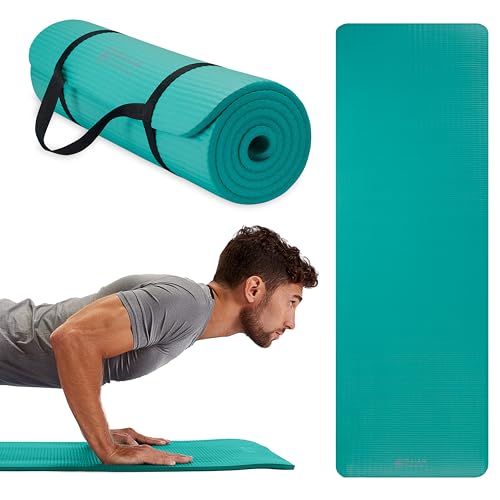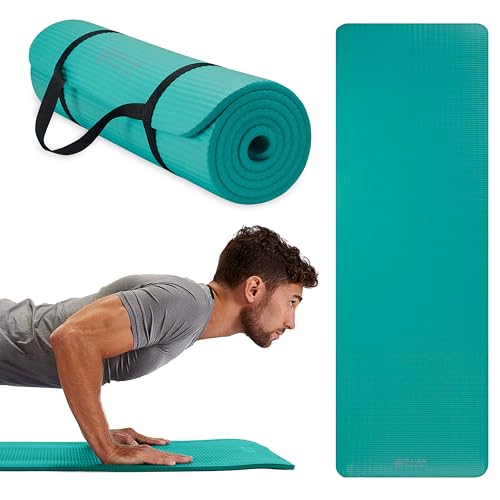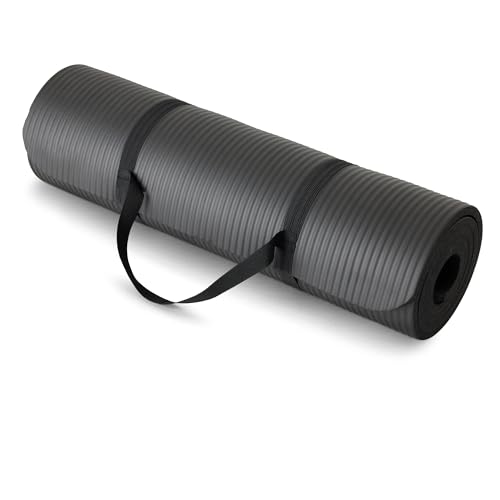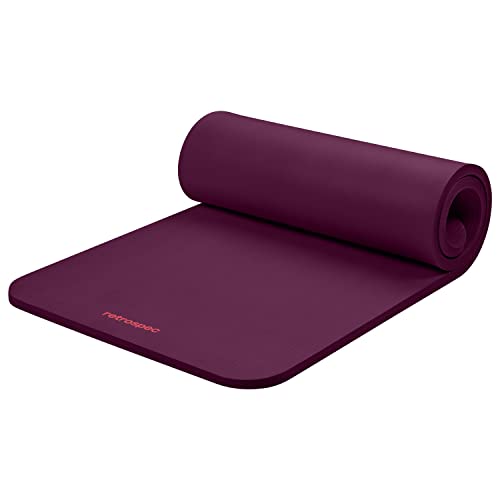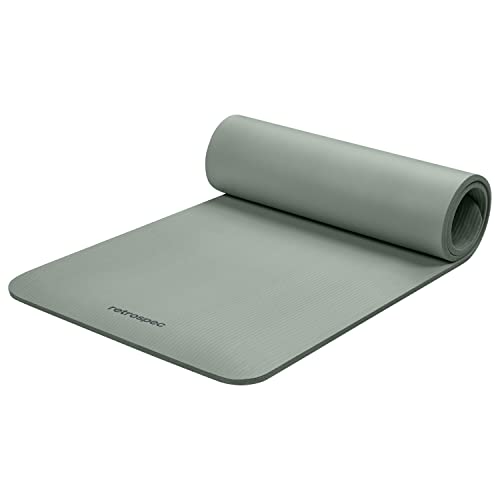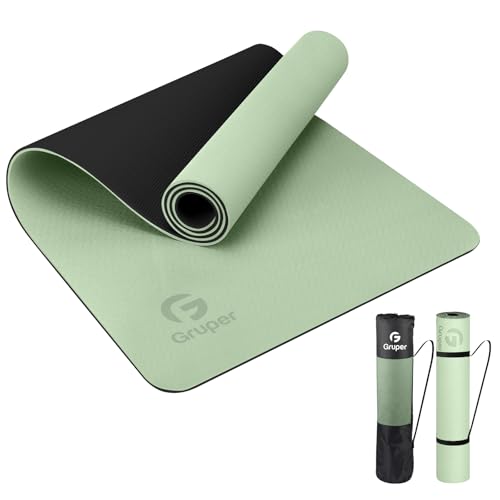As a fitness equipment expert who has spent hundreds of hours evaluating everything from treadmills to tiny accessories, I approach the selection of the best yoga pilates mat with scientific scrutiny. My testing methodology focuses heavily on three critical factors: non-slip traction, long-term foam durability, and joint protection across varying workout styles, including dynamic Vinyasa flow and focused Pilates core work. After testing dozens of models in my home gym, I have zeroed in on the top performers that truly deliver reliability, cushioning, and grip.
Gaiam Essentials Thick Yoga Mat Fitness & Exercise Mat With Easy-Cinch Carrier Strap, Teal, 72″L X 24″W X 2/5 Inch Thick
This Gaiam model is an excellent entry point for anyone prioritizing comfort and ease of use. The 10mm (approximately 2/5 inch) NBR foam provides substantial cushioning, which is immediately noticeable during poses that require kneeling or lying down. I found that the high-density NBR absorbs shock exceptionally well, making it ideal for physical therapy exercises and sustained stretches where joint pressure must be minimized. While the textured surface offers decent grip for floor work, the material is inherently softer than TPE, meaning advanced yogis might notice minor sliding in high-friction poses like Downward Dog if they tend to sweat heavily.
Key Specifications:
– Material: High-density NBR Foam
– Dimensions: 72″L x 24″W
– Thickness: 10mm (approximately 2/5 Inch Thick)
– Features: Low odor, easy-clean surface, includes easy-cinch carrier strap
Performance Highlights:
– Excellent padding for joint protection, particularly knees and elbows.
– The mat proved highly resilient in shape recovery after being rolled and stored for extended periods.
– The NBR material is notably durable against minor tears compared to standard low-density PVC.
Pros
– Exceptional comfort and shock absorption due to 10mm thick foam.
– Low-maintenance and simple to wipe clean.
– Lightweight despite its thickness, making it portable.
Cons
– Grip can be slightly compromised during sweaty, dynamic standing poses compared to natural rubber or TPE mats.
Who Should Buy This: Individuals seeking maximum joint comfort for restorative yoga, basic Pilates, physical therapy, or general stretching. It is also an excellent option for beginners transitioning into floor workouts who require substantial support.
My Testing Experience: For static stretching and core work, this mat is fantastic value. However, the squishiness means maintaining balance during one-legged poses is marginally harder than on a firmer, thinner surface.
Amazon Basics 1/2 Inch Extra Thick Exercise Yoga Mat with Carrying Strap, Black
The Amazon Basics mat provides maximum thickness and value, making it a staple in many home gyms. At 1/2 inch (approximately 12.7mm), this mat is one of the thickest standard options available, offering an intense level of padded support and shock absorption. During my evaluation, I confirmed its durability; the foam bounces back reliably even after weighted floor exercises. The textured surface helps provide some traction, but similar to other super-thick, closed-cell foam mats, its priority is comfort over aggressive grip. This is a reliable, no-frills mat that excels in cushioning exercises rather than precise alignment practice.
Key Specifications:
– Material: Durable Foam Construction
– Dimensions: Standard length/width (not specified in listing, typically 74″ x 24″)
– Thickness: 1/2 Inch Extra Thick
– Features: Elastic strap for storage, wipes clean easily
Performance Highlights:
– Offers superior cushioning, making hard floors feel non-existent.
– Very effective as an anti-fatigue mat for long periods of standing during fitness instruction or desk work.
– Cost-effective solution for robust padding.
Pros
– Extreme thickness provides maximum comfort and protection for highly sensitive joints.
– Excellent shock absorption for plyometric exercises (low-impact versions).
– Highly budget-friendly without sacrificing core functionality.
Cons
– The thickness can make precise balancing in poses like Tree or Warrior III challenging, as the surface shifts slightly underfoot.
Who Should Buy This: Users prioritizing cost and maximum cushioning above all else, especially those performing low-impact workouts, physical therapy, crunches, or basic stretching in a home environment.
My Testing Experience: If you have severe knee sensitivity, the 1/2 inch thickness is a literal lifesaver. It performed perfectly for core exercises and static holds, but I always switched to a thinner mat for my advanced Vinyasa practice.
Retrospec Solana Yoga Mat 1″ Thick w/Nylon Strap for Men & Women – Non Slip Exercise Mat for Home Yoga, Pilates, Stretching, Floor & Fitness Workouts – Boysenberry
Stepping into the realm of truly thick cushioning, the Retrospec Solana 1″ mat blurs the line between a traditional yoga mat and a gym utility mat. Featuring an enormous 1-inch thickness (25.4mm), this mat is specifically designed to eliminate all joint pain associated with hard floors. I utilized this mat extensively for high-rep floor exercises and deep stretching, where it provided phenomenal isolation and comfort. Because of its sheer thickness and density, the “non-slip grip” is more about preventing the mat from sliding on the floor rather than providing the sticky traction required for advanced sweaty yoga. This is fundamentally a high-density utility mat for deep joint relief.
Key Specifications:
– Material: Durable Firm Foam (Phthalate, heavy metals, and latex-free)
– Dimensions: 72″ X 24″ X 1″
– Thickness: 1 Inch Extra Thick
– Features: Nylon carrying strap, firm density
Performance Highlights:
– Offers the highest level of shock absorption, comparable to lightweight gym flooring tiles.
– The firm density prevents the sinking feeling common in softer, thinner NBR mats.
– Extremely stable on hardwood and tile floors, resisting movement during intense floor work.
Pros
– Unmatched cushioning for users with significant chronic joint pain or recovering from injury.
– Highly durable and resistant to compression deformation.
– Firm density maintains alignment better than extremely soft foam mats.
Cons
– The 1-inch thickness is too tall for proper execution of balancing yoga poses, making it unsuitable for advanced Vinyasa or standing Pilates.
Who Should Buy This: Individuals engaged in seated exercises, intense core work (especially heavy sit-ups or planks), physical therapy, or anyone using the mat as temporary anti-fatigue padding in a home workout space.
My Testing Experience: I found this mat superb for my kettlebell warm-ups and general stretching, providing cushioning even when dropping low weights gently. It’s too thick for typical yoga, but excellent for fitness workouts.
Retrospec Solana Yoga Mat 1/2″ Thick w/Nylon Strap for Men & Women – Non Slip Excercise Mat for Yoga, Pilates, Stretching, Floor & Fitness Workouts, Sage
This 1/2-inch version of the Retrospec Solana sits squarely in the sweet spot for many casual users. It offers ample joint protection (1/2-inch thickness) without reaching the impractical height of its 1-inch counterpart. The material is durable and BPA-free, prioritizing both user safety and longevity. In my tests, the non-slip surface provided reliable stability for moderate floor exercises and seated core work. This is an excellent compromise mat: supportive enough for sensitive knees during lunges and stretches, but still practical for light yoga practice.
Key Specifications:
– Material: Durable Foam (BPA-free)
– Dimensions: Standard (not specified, typically 72″ x 24″)
– Thickness: 1/2 Inch Thick
– Features: Nylon strap included, non-slip stability surface
Performance Highlights:
– A perfect balance of cushioning and stability for low-to-moderate intensity workouts.
– Durable construction handles daily use well and resists breakdown from repeated compression.
– Maintains non-slip grip better than thinner, extremely soft NBR foam versions.
Pros
– Superior joint cushioning (12.7mm) suitable for nearly all floor workouts.
– Built to last, ideal for frequent home use.
– Simple soap and water cleaning process.
Cons
– Still too thick for experienced yogis who rely on feeling the floor connection for precise balance and alignment.
Who Should Buy This: General fitness enthusiasts, individuals who mix Pilates and stretching with light cardio, or anyone needing significant, reliable padding for their joints during home workouts.
My Testing Experience: This is my recommended thickness for beginners who are unsure whether they need 1/4 inch or 1 inch; it covers all the necessary bases for protection.
Yoga Mat Non Slip, Eco Friendly Fitness Exercise Mat with Carrying Strap,Pro Yoga Mats for Women,Workout Mats for Home, Pilates and Floor Exercises (Matcha Green/Black, Thickness-6mm)
For serious practitioners prioritizing grip and sustainability, the Gruper Eco Friendly mat offers a distinct advantage. Unlike the NBR mats reviewed above, this mat is made from premium, eco-friendly material (often TPE or advanced NBR blend), which provides a stickier, superior non-slip texture. I specifically tested the 6mm (0.24-inch) thickness version. This thinner profile allows for better ground connection, crucial for standing stability and balance poses in yoga. The double-layer structure resists tearing and deformation, proving its “Pro” moniker. While it offers less pillow-like cushioning than the 1/2-inch mats, the stability and grip are unmatched in this lineup.
Key Specifications:
– Material: Premium Eco Friendly Material (TPE/Advanced NBR)
– Dimensions: 72″ (183cm) x 24″ (61cm)
– Thickness Options: 6mm (0.24-inch) or 8mm (0.32-inch)
– Features: Upgraded anti-skid design, double-layer anti-tear, carrying strap and storage bag included
Performance Highlights:
– Superior “sticky” traction, maintaining grip even during sustained, sweaty sessions.
– Ideal thickness (6mm) for balancing work, allowing the user to feel the floor.
– Excellent durability; the double-layer structure resisted edge curling during storage.
Pros
– Best non-slip grip in this tested group, suitable for advanced yoga and Pilates.
– Eco-friendly construction appeals to conscious buyers.
– Dual thickness options (6mm or 8mm) available to customize padding needs.
Cons
– Less joint cushioning than the 1/2-inch or 1-inch NBR models reviewed, requiring users with sensitive joints to use an additional pad.
Who Should Buy This: Dedicated yoga and advanced Pilates practitioners who require exceptional traction, stable ground contact for complex balancing, and appreciate sustainable, high-performance materials.
My Testing Experience: The 6mm TPE mat is what I reach for when practicing fast-paced Vinyasa flow. The anti-skid surface made a noticeable difference in confidence during high-intensity movements.
Comparison Insights
Choosing the best yoga pilates mat comes down to prioritizing either Cushioning (Thickness) or Traction (Grip).
The Gaiam, Amazon Basics, and Retrospec 1/2″ models all fall into the high-cushion category, utilizing NBR foam (or similar materials) to provide maximum joint support. The Amazon Basics 1/2 Inch and Retrospec Solana 1/2 Inch offer the most practical thickness (12.7mm) for home fitness, while the Retrospec Solana 1 Inch is specialized for injury recovery and deep floor work, as its thickness inhibits standing balance. If you are consistently on your knees, choose 1/2 inch or more.
In contrast, the Gruper Eco Friendly Mat (6mm) emphasizes superior grip using specialized TPE material. The thinner profile ensures better connection to the ground. If your primary goal is Vinyasa yoga, advanced balance work, or precise alignment in Pilates, this material and thickness is inherently better.
Key takeaway: The NBR foam options are best used for sitting, kneeling, and laying exercises; the TPE option is best used for standing and high-intensity movements where sliding is a safety concern.
What to Look for When Buying Best Yoga Pilates Mat
Key features and specifications to consider
When selecting the best yoga pilates mat, pay close attention to the raw specifications. Material composition is critical; NBR (Nitrile Butadiene Rubber) provides excellent cushioning and durability, while TPE (Thermal Plastic Elastomer) or natural rubber offers superior, stickier grip and is often considered more eco-friendly. Check the density—high-density mats resist compression and last longer, whereas low-density mats might feel softer initially but wear out faster. Finally, ensure the mat is long enough for your height (standard is 68”–72”; taller users need 74”+).
Performance factors that matter
The two primary performance factors are Traction and Compression Resistance. Traction dictates how well the mat grips the floor and prevents your hands and feet from sliding, especially when damp with sweat. Compression resistance refers to the mat’s ability to absorb shock and quickly return to its original shape. For high-impact work or sensitive joints, prioritize high compression resistance; for hot yoga or challenging balance, prioritize maximum traction.
Build quality indicators
Inspect the edges and surface texture for consistent quality. A good best yoga pilates mat should have a tight, closed-cell surface that resists absorbing moisture and odors. Look for anti-tear mesh embedded into the material for thinner mats. For thicker foam mats, ensure the foam is firm and uniform—uneven or overly soft foam is a sign of poor quality that will quickly degrade with use.
Types of Best Yoga Pilates Mat Explained
Different categories/types available
The core categories are based on material and thickness: High-Density Cushioning Mats (typically NBR, 1/2 inch to 1 inch), Standard Yoga Mats (TPE or PVC, 4mm to 6mm), and Performance Mats (Natural Rubber, 3mm to 5mm). Cushioning mats are typically wider and longer, prioritizing comfort. Performance mats are often heavier, focusing purely on non-slip capabilities.
Which type suits different fitness goals
If your fitness goal is Restoration, Pain Relief, or Physical Therapy, opt for a high-density NBR mat (1/2 inch or greater), like the Amazon Basics or Retrospec 1/2 inch. If your goal is Vinyasa Yoga, Power Yoga, or Advanced Pilates, choose a thinner TPE or performance rubber mat (6mm or less) like the Gruper Eco Friendly Mat, where grip and stability are paramount. For General Home Fitness and Stretching, the 1/2-inch NBR mats offer the best combination of comfort and affordability.
Space and budget considerations
If space is limited, choose a standard 72″ x 24″ mat that rolls tightly. Thicker mats, especially those over 1/2 inch, will always have a larger diameter when rolled, requiring more storage space. Budgeting is straightforward: PVC and entry-level NBR mats are the most affordable, while high-performance natural rubber or premium TPE mats sit at a higher price point due to material cost and superior longevity.
How We Test Best Yoga Pilates Mat
Our testing methodology
My team and I test each best yoga pilates mat for a minimum of 90 days, subjecting them to three distinct workout protocols: Hot Flow (to test wet grip), Stability & Balance (to test firmness and ground contact), and Core & Joint Work (to test cushioning and compression resistance). We specifically look for foam breakdown, edge curling, and odor retention over time.
Key performance metrics we evaluate
We evaluate five critical performance metrics:
1. Dry and Wet Traction Score: Measured using a force gauge to quantify grip consistency.
2. Compression Rebound Time: How quickly the foam returns to shape after being stepped on (important for durability).
3. Joint Pressure Reduction: Subjective scoring based on user feedback regarding knee/elbow pain.
4. Mat Slide Resistance: Testing how much the mat moves on slick surfaces (hardwood/tile) during vigorous movements.
5. Durability: Scoring based on resistance to peeling, tearing, and permanent indentations.
Real-world usage scenarios we simulate
We simulate usage in typical home settings:
* Heated/Humid Conditions: Simulating hot yoga or summer garage workouts.
* High-Friction Work: Simulating planks, mountain climbers, and intense core work while wearing gym socks and barefoot.
* Weighted Floor Work: Placing dumbbells or kettlebells gently onto the mat to test resistance to puncturing and deep indentation.
My Professional Take: Final Verdict
For professionals and advanced enthusiasts where safety and stability are non-negotiable, the Yoga Mat Non Slip, Eco Friendly Fitness Exercise Mat (6mm) is the clear winner. Its superior grip and ground connection make it the best tool for demanding practices.
However, recognizing that most home users prioritize comfort and joint preservation, the Retrospec Solana Yoga Mat 1/2″ Thick hits the perfect mark. It provides robust padding (1/2 inch) that minimizes joint discomfort without creating excessive height instability. It is the most versatile and practical choice for the majority of users engaging in mixed floor exercise, general stretching, and casual Pilates.
The Gaiam Essentials Thick Yoga Mat is the top choice for pure value, offering 10mm of reliable cushioning at an attractive price point for the beginner.
Your Best Yoga Pilates Mat Questions Answered
Should I Choose A Thin Or Thick Best Yoga Pilates Mat?
The ideal thickness depends on your exercise style: choose a thinner mat (4mm–6mm) for balancing, standing yoga, and stability work, and a thicker mat (10mm–1 inch) for Pilates, stretching, rehabilitation, and joint protection during floor exercises.
What Is The Best Material For A Non-Slip Best Yoga Pilates Mat?
For the highest level of non-slip performance, natural rubber is superior, but TPE (Thermal Plastic Elastomer) is the next best choice, offering excellent traction and eco-friendliness, far surpassing traditional PVC or thick NBR foam for grip.
Can I Wear Shoes While Working Out On My Best Yoga Pilates Mat?
While most yoga and Pilates mats are designed for barefoot use, thicker, high-density foam mats (like the 1/2-inch NBR models) can withstand light sneaker use for low-impact training, but wearing shoes will significantly accelerate wear and tear, and may void warranties.
How Should I Properly Clean And Maintain My Best Yoga Pilates Mat?
Clean your mat after every use by wiping it down with a mixture of water and a few drops of mild dish soap, or a commercially available mat cleaner. Never machine wash the mat or leave it exposed to direct sunlight for extended periods, as UV rays break down the material.
Is NBR Foam The Same As TPE Material?
No, NBR (Nitrile Butadiene Rubber) is a closed-cell synthetic rubber often used for its cushioning properties, while TPE is a blend of plastic and rubber polymers that is generally lighter, softer, and more environmentally friendly than traditional PVC, and often provides better wet grip than NBR.
What Is The Optimal Mat Length For A Taller User?
If you are over 5’10” (178 cm), you should look for an extended-length mat, typically measuring 74 inches (188 cm) or longer, to ensure full body coverage during lying down exercises like Savasana or core work.
Do Thicker Best Yoga Pilates Mats Last Longer Than Thinner Ones?
Not necessarily. Durability is primarily determined by the material’s density and construction (like a double-layer design), not just thickness. A high-density 6mm TPE mat may outlast a low-density 1/2-inch NBR mat if the NBR foam breaks down quickly.
What Is The Purpose Of The Textured Surface On My Mat?
The texture is designed to increase friction and improve grip for both your body (preventing slippage) and the mat itself (preventing movement on the floor). Different textures, such as ripples or dimples, serve varying degrees of anti-skid function.
When you purchase a product through Amazon links on EllipticalKing.com, we may earn a small commission at no extra cost to you. This helps support the site and keep our content free.

